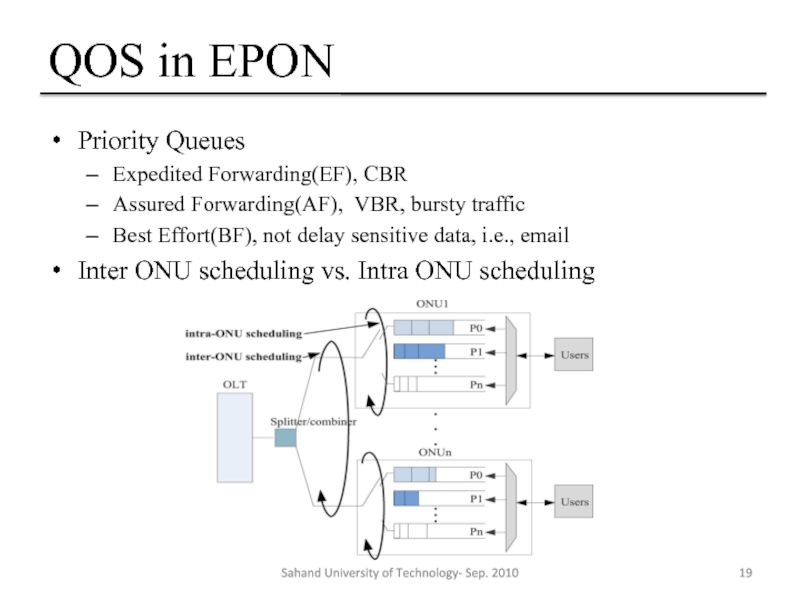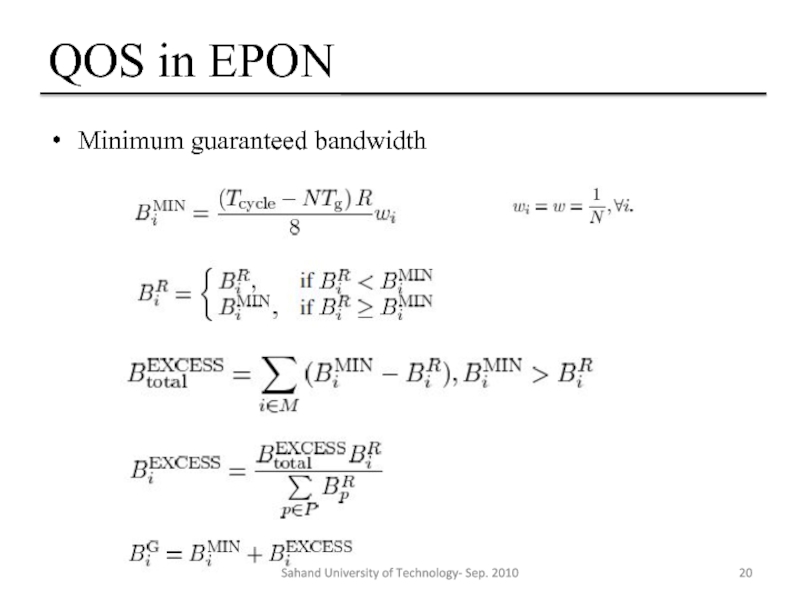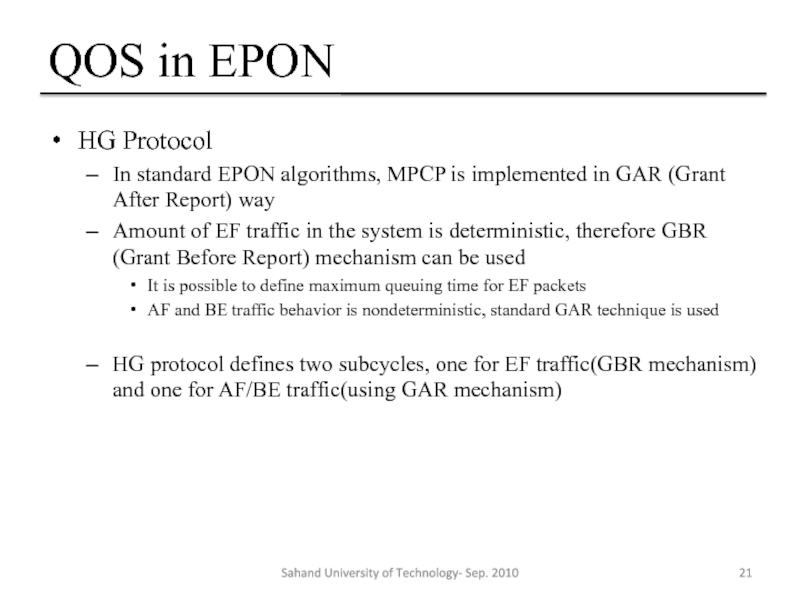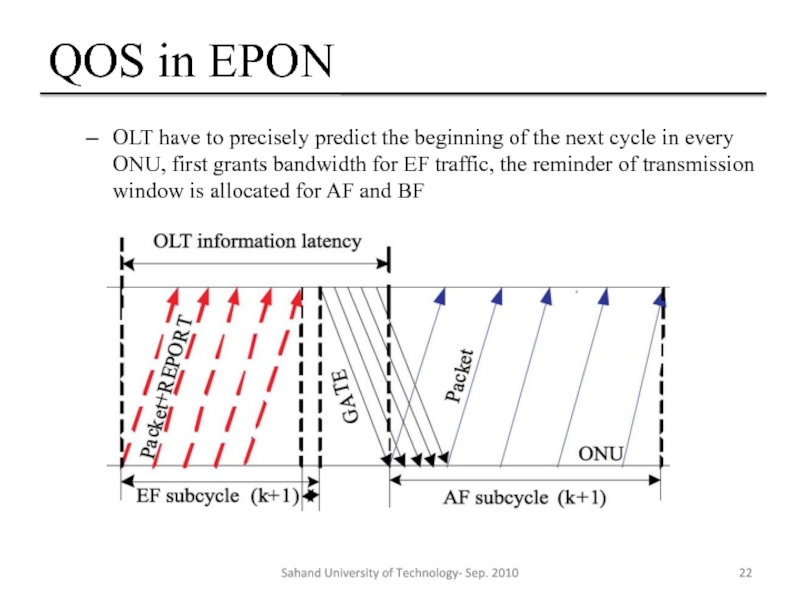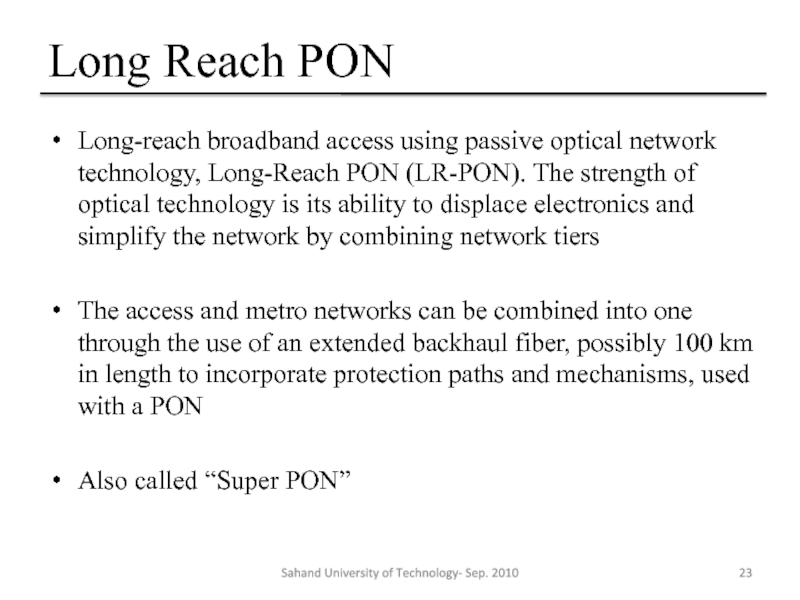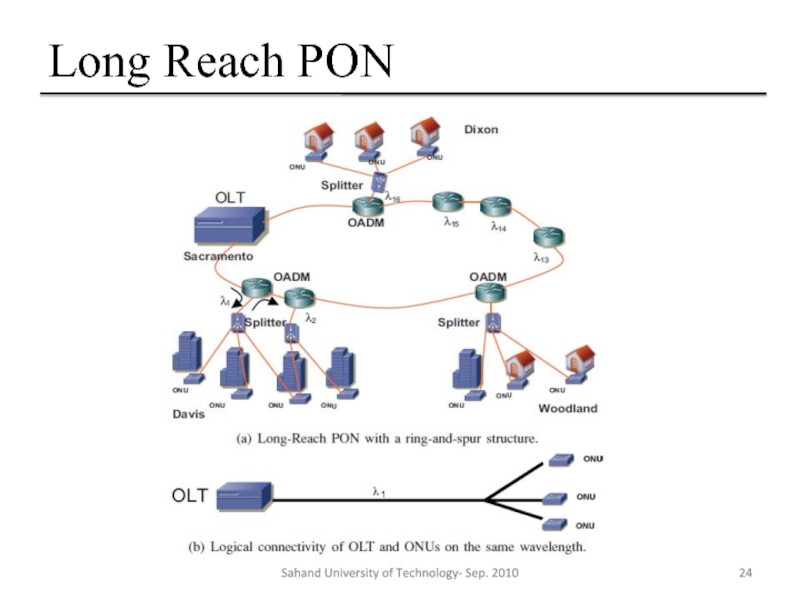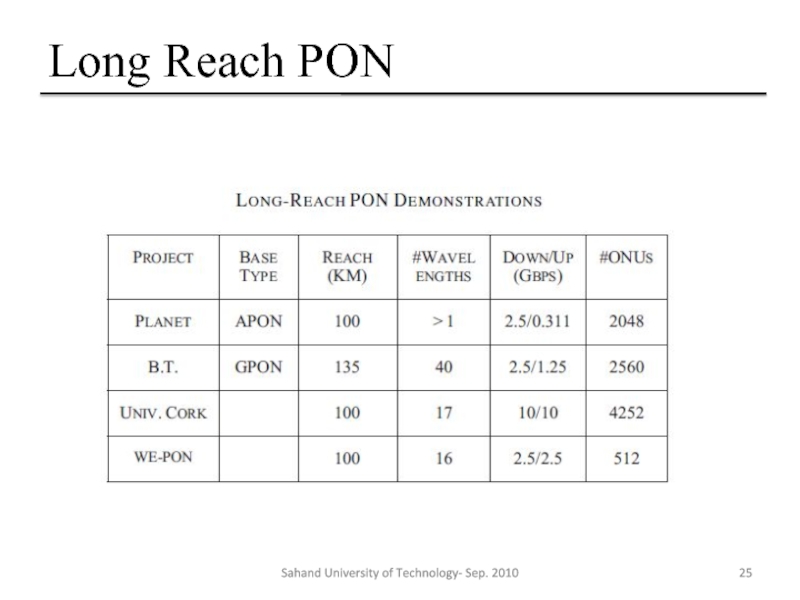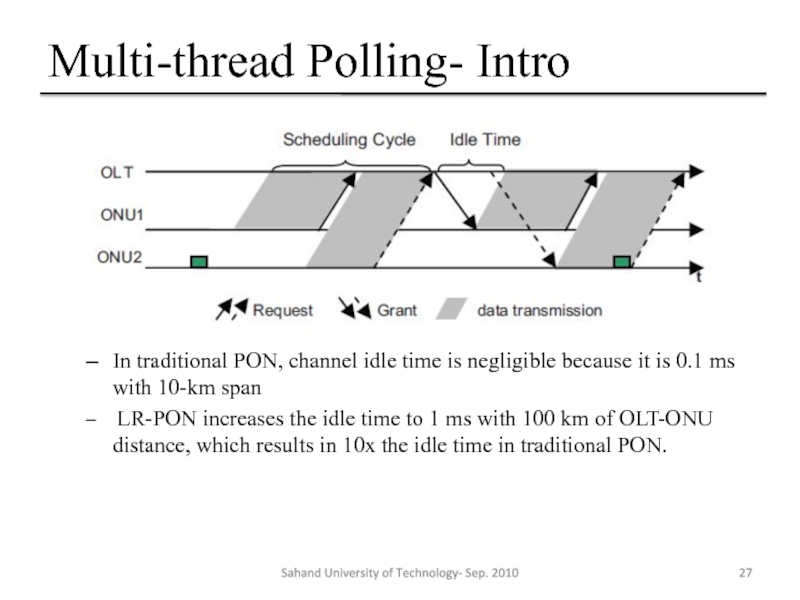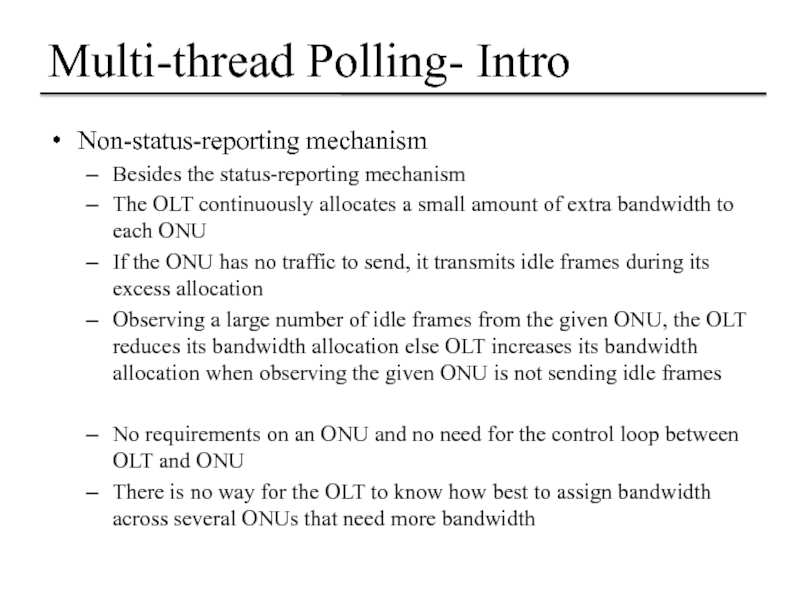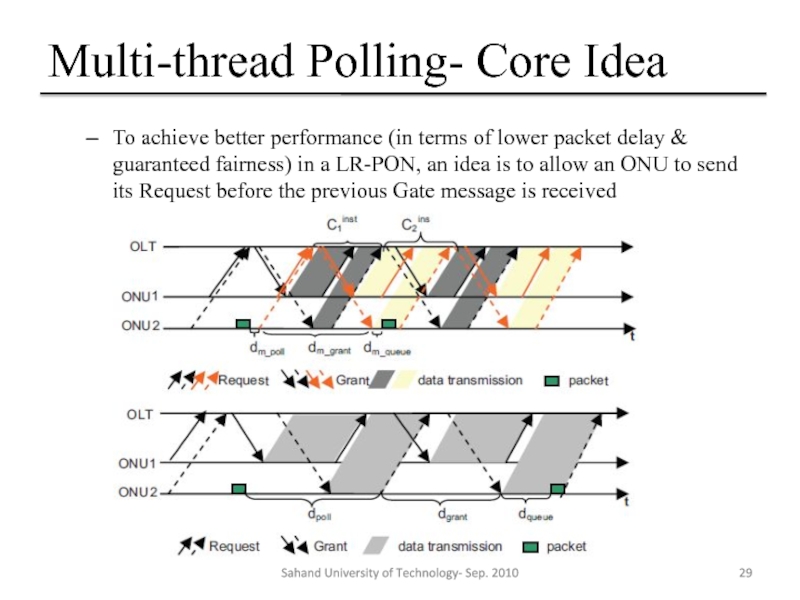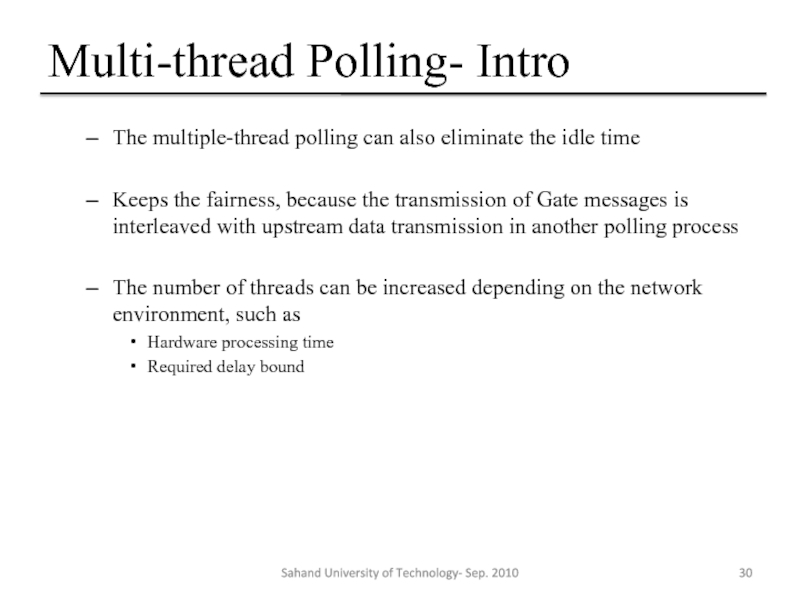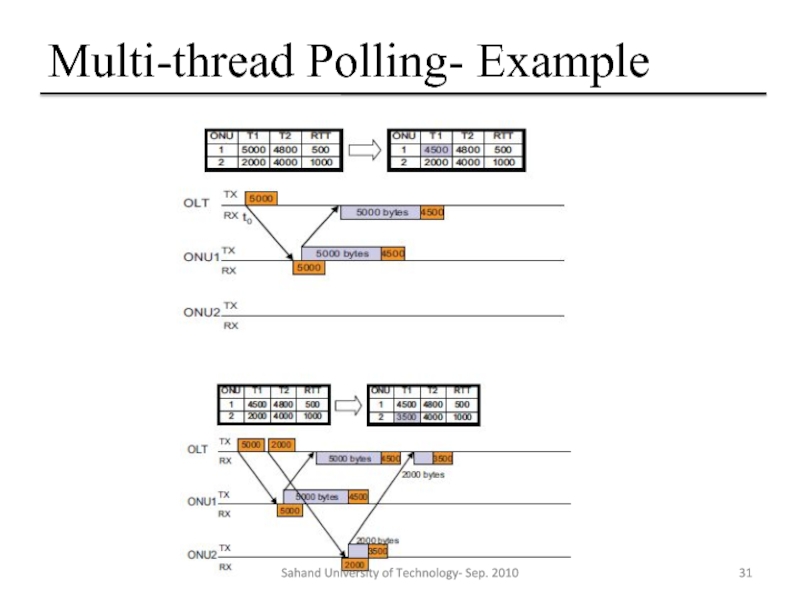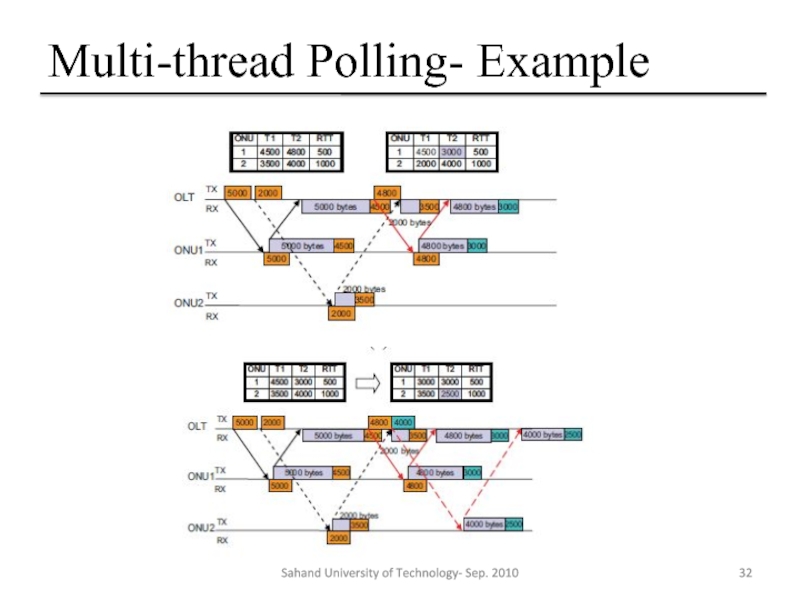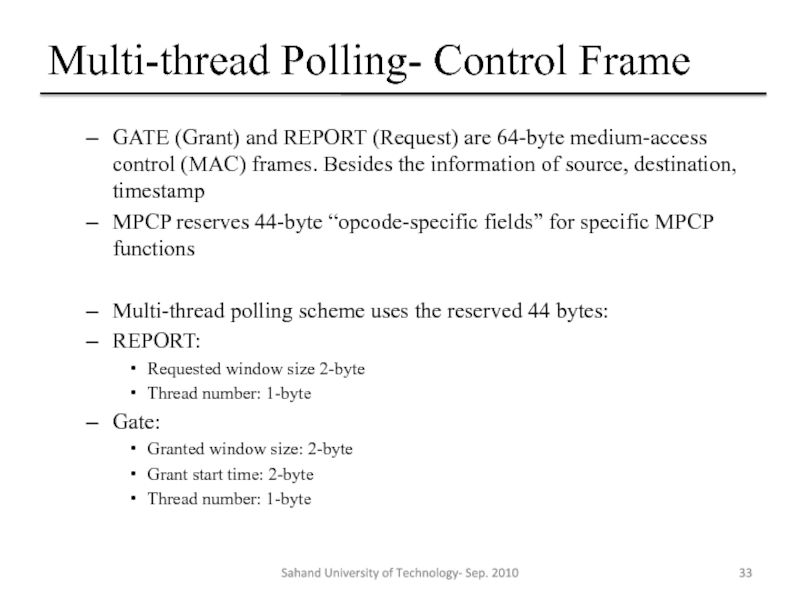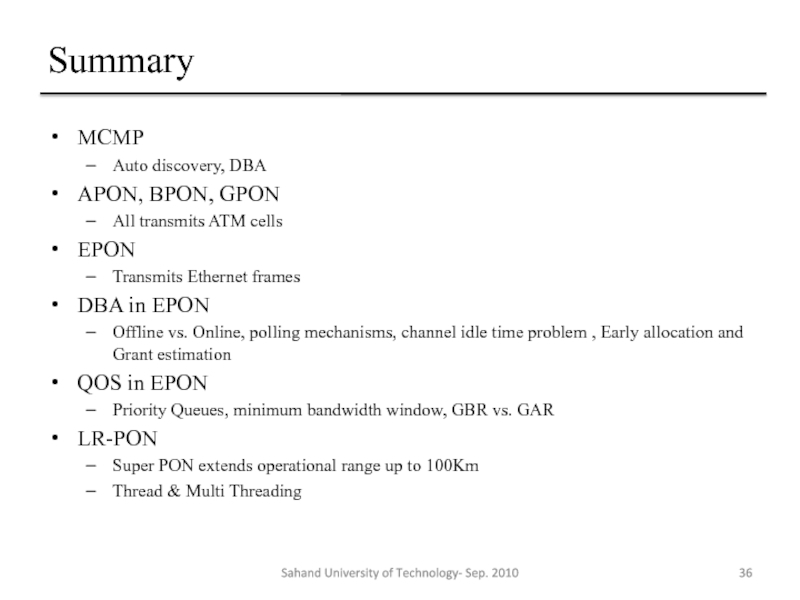- Главная
- Разное
- Дизайн
- Бизнес и предпринимательство
- Аналитика
- Образование
- Развлечения
- Красота и здоровье
- Финансы
- Государство
- Путешествия
- Спорт
- Недвижимость
- Армия
- Графика
- Культурология
- Еда и кулинария
- Лингвистика
- Английский язык
- Астрономия
- Алгебра
- Биология
- География
- Детские презентации
- Информатика
- История
- Литература
- Маркетинг
- Математика
- Медицина
- Менеджмент
- Музыка
- МХК
- Немецкий язык
- ОБЖ
- Обществознание
- Окружающий мир
- Педагогика
- Русский язык
- Технология
- Физика
- Философия
- Химия
- Шаблоны, картинки для презентаций
- Экология
- Экономика
- Юриспруденция
DBA In EPON & LR-PON презентация
Содержание
- 1. DBA In EPON & LR-PON
- 2. Agenda Introduction to Passive Optical Network EPON
- 3. Passive Optical Network Passive Optical Network(PON) is
- 4. Passive Optical Network Sahand University of Technology- Sep. 2010
- 5. Topologies Optical Line Terminal(OLT) Optical Network Unit(ONU)
- 6. Topologies Redundant PON Two stage PON
- 7. Advantages Longer operational range, PON operates at
- 8. Ethernet PON(EPON) PONs are categorized by their
- 9. Medium Access Control- Intro Channel Separation Space-division
- 10. Medium Access Control- Intro WDM Provides
- 11. Medium Access Control- Intro Multipoint control protocol
- 12. Medium Access Control- Intro Polling policies Poll
- 13. DBA - IPACT A brief study of
- 14. DBA - IPACT Guard time is used
- 15. DBA - IPACT Gate Message Problems High
- 16. DBA - IPACT Sahand University of Technology- Sep. 2010
- 17. DBA – WDM IPACT… DWM IPACT Descendant
- 18. DBA To more utilization in EPON In
- 19. QOS in EPON Priority Queues Expedited Forwarding(EF),
- 20. QOS in EPON Minimum guaranteed bandwidth
- 21. QOS in EPON HG Protocol In standard
- 22. QOS in EPON OLT have to precisely
- 23. Long Reach PON Long-reach broadband access using
- 24. Long Reach PON Sahand University of Technology- Sep. 2010
- 25. Long Reach PON Sahand University of Technology- Sep. 2010
- 26. Multi-thread Polling- Intro Status-reporting mechanism
- 27. Multi-thread Polling- Intro
- 28. Multi-thread Polling- Intro Non-status-reporting mechanism Besides the
- 29. Multi-thread Polling- Core Idea To achieve better
- 30. Multi-thread Polling- Intro The multiple-thread polling can
- 31. Multi-thread Polling- Example Sahand University of Technology- Sep. 2010
- 32. Multi-thread Polling- Example Sahand University of Technology- Sep. 2010
- 33. Multi-thread Polling- Control Frame GATE (Grant)
- 34. Multi-thread Polling-Initiating When OLT initiates multiple threads,
- 35. Multi-thread Polling-Inter-Thread Scheduling In multi-thread polling, OLT
- 36. Summary MCMP Auto discovery, DBA APON, BPON,
Слайд 1DBA
In EPON & LR-PON
Sahand University of Technology
Ali Razmkhah
Dr. Ghaffarpour
Sahand University
Слайд 2Agenda
Introduction to Passive Optical Network
EPON
MPCM
DBA
Quality of service
Introduction to LR-PON
DBA
Sahand University of
Слайд 3Passive Optical Network
Passive Optical Network(PON) is a point to multipoint optical
Interior elements such as passive splitters, combiners and splitters
PON technology is one of solutions for “Last Mile” problem
Sahand University of Technology- Sep. 2010
Слайд 5Topologies
Optical Line Terminal(OLT)
Optical Network Unit(ONU)
Splitter/combiner(SC)
Tree
Ring
Bus
Sahand University of Technology- Sep. 2010
Слайд 6Topologies
Redundant PON
Two stage PON
Data streams
Upstream
Downstream
Sahand University of Technology-
Слайд 7Advantages
Longer operational range, PON operates at distance of 20 km
DSL
PON minimizes fiber deployment
Shared channel from SC to OLT
Provides higher bandwidth
Single wavelength provides at least 1 Gb/s
Allows video broadcasting
In downstream direction from OLT to ONUs
Easy upgrade to higher bitrates
By deploying additional wavelengths
Sahand University of Technology- Sep. 2010
Слайд 8Ethernet PON(EPON)
PONs are categorized by their data link layer
APON
BPON
GPON
EPON
EPON
Introduced by Glen
Transmits Ethernet frames
Ethernet frames form 90% of total traffic
No frame conversion
Sahand University of Technology- Sep. 2010
Слайд 9Medium Access Control- Intro
Channel Separation
Space-division multiplexing, where two separate optical fibers
A single coupler and a single fiber for both directions with one wavelength for upstream transmission and another for downstream transmission, i.e., 1310nm and 1550 nm
Multiple Access
In the upstream, multiple ONUs transmit data packets to the OLT
Due to the directional property of a passive combiner, data packets from an ONU can't reach to the other ONUs, conventional contention-based multiple access, e.g., CSMA/CD, doesn't suitable for EPON
Sahand University of Technology- Sep. 2010
Слайд 10Medium Access Control- Intro
WDM
Provides high bandwidth, simple to implement
Cost and
TDM
Each ONU has a fraction of channel bandwidth
Synchronization, more complicated than WDM
CDM
Security
Inter channel interference increases by increasing number of user
Sahand University of Technology- Sep. 2010
Слайд 11Medium Access Control- Intro
Multipoint control protocol (MPCP)
Standardized by the IEEE802.3ah Ethernet
Applications
Auto-discovery, Registration, Ranging (RTT computation)
Register
Register request
Register ack
DBA
Report message
Head of frame
Tail of frame
Gate message
Fixed granting
Gate assignment granting
Limited granting
Sahand University of Technology- Sep. 2010
Слайд 12Medium Access Control- Intro
Polling policies
Poll & stop polling
Interleaved polling
Interleaved polling with
Scheduling modes
Online
Offline
Sahand University of Technology- Sep. 2010
Слайд 13DBA - IPACT
A brief study of
IPACT
WDM IPACT
IGFS
DPA
All of aforementioned protocols work
IPACT
Sahand University of Technology- Sep. 2010
Слайд 14DBA - IPACT
Guard time is used to:
Avoid collision due to clock
Adjust the OLT receiver
Sahand University of Technology- Sep. 2010
Слайд 15DBA - IPACT
Gate Message Problems
High downstream load vs. light upstream load
Gate
Solution:
Dedicated control channel for Gate messages
Disconnected ONU
OLT can stop polling disconnected ONU in every cycle(simple solution)
OLT must distinguish between corrupted Report and disconnected ONU
OLT polls disconnected ONU less frequently
Sahand University of Technology- Sep. 2010
Слайд 17DBA – WDM IPACT…
DWM IPACT
Descendant of simple IPACT, where multiple wavelength
Higher upstream bandwidth than simple IPACT
IGFS:
Uses gaps that are created by dissimilarity in RTTs to utilize upstream channel
More efficient than WDM IPACT
DPA
Divides ONUs in two subgroup with some overlap
OLT performs DBA for a group, while receives data from other one
In some cases removes channel idle time
Sahand University of Technology- Sep. 2010
Слайд 18DBA
To more utilization in EPON
In [1] a DBA has been proposed
In [2] a DBA was introduced which predicts and schedules constant bit- rate (CBR) traffic to transmit during the idle time, but it works on a more detailed traffic classification and a certain traffic pattern
[1]: C. Assi, Y. Ye, S. Dixit, and M. Ali, “Dynamic bandwidth allocation for quality-of-service over ethernet PONs,” IEEE J. Select. Areas Commun., vol. 21, no. 9, pp. 1467-1477, Nov. 2003.
[2]:A. Shami, X. Bai, C. Assi, and N. Ghani, “Jitter performance in ethernet passive optical networks,” J. Lightware Technol., vol. 23, no. 4, pp. 1745-1753, Apr. 2005.
Sahand University of Technology- Sep. 2010
Слайд 19QOS in EPON
Priority Queues
Expedited Forwarding(EF), CBR
Assured Forwarding(AF), VBR, bursty traffic
Best Effort(BF),
Inter ONU scheduling vs. Intra ONU scheduling
Sahand University of Technology- Sep. 2010
Слайд 21QOS in EPON
HG Protocol
In standard EPON algorithms, MPCP is implemented in
Amount of EF traffic in the system is deterministic, therefore GBR (Grant Before Report) mechanism can be used
It is possible to define maximum queuing time for EF packets
AF and BE traffic behavior is nondeterministic, standard GAR technique is used
HG protocol defines two subcycles, one for EF traffic(GBR mechanism) and one for AF/BE traffic(using GAR mechanism)
Sahand University of Technology- Sep. 2010
Слайд 22QOS in EPON
OLT have to precisely predict the beginning of the
Sahand University of Technology- Sep. 2010
Слайд 23Long Reach PON
Long-reach broadband access using passive optical network technology, Long-Reach
The access and metro networks can be combined into one through the use of an extended backhaul fiber, possibly 100 km in length to incorporate protection paths and mechanisms, used with a PON
Also called “Super PON”
Sahand University of Technology- Sep. 2010
Слайд 26Multi-thread Polling- Intro
Status-reporting mechanism
Applying this to LR-PON, we can find the
Single thread
Sahand University of Technology- Sep. 2010
Слайд 27Multi-thread Polling- Intro
In traditional PON, channel idle time is negligible because
LR-PON increases the idle time to 1 ms with 100 km of OLT-ONU distance, which results in 10x the idle time in traditional PON.
Sahand University of Technology- Sep. 2010
Слайд 28Multi-thread Polling- Intro
Non-status-reporting mechanism
Besides the status-reporting mechanism
The OLT continuously allocates a
If the ONU has no traffic to send, it transmits idle frames during its excess allocation
Observing a large number of idle frames from the given ONU, the OLT reduces its bandwidth allocation else OLT increases its bandwidth allocation when observing the given ONU is not sending idle frames
No requirements on an ONU and no need for the control loop between OLT and ONU
There is no way for the OLT to know how best to assign bandwidth across several ONUs that need more bandwidth
Слайд 29Multi-thread Polling- Core Idea
To achieve better performance (in terms of lower
Sahand University of Technology- Sep. 2010
Слайд 30Multi-thread Polling- Intro
The multiple-thread polling can also eliminate the idle time
Keeps
The number of threads can be increased depending on the network environment, such as
Hardware processing time
Required delay bound
Sahand University of Technology- Sep. 2010
Слайд 33Multi-thread Polling- Control Frame
GATE (Grant) and REPORT (Request) are 64-byte
MPCP reserves 44-byte “opcode-specific fields” for specific MPCP functions
Multi-thread polling scheme uses the reserved 44 bytes:
REPORT:
Requested window size 2-byte
Thread number: 1-byte
Gate:
Granted window size: 2-byte
Grant start time: 2-byte
Thread number: 1-byte
Sahand University of Technology- Sep. 2010
Слайд 34Multi-thread Polling-Initiating
When OLT initiates multiple threads, the initial cycle time of
Tprocess is the Request processing time at the OLT
Sahand University of Technology- Sep. 2010
Слайд 35Multi-thread Polling-Inter-Thread Scheduling
In multi-thread polling, OLT can make use of not
For example, consider that three threads T1, T2, and T3. Before OLT calculates bandwidth allocation in T1, Requests in T2 have arrived, which report the latest information of ONUs’ packet queues
This information will be counted in the bandwidth allocation in T1. Thus, packets arriving at ONUs in T2 will not be queued until Gates of T2 are received; instead, they can be transmitted in T1. So, the average packet delay can be further optimized
Sahand University of Technology- Sep. 2010
Слайд 36Summary
MCMP
Auto discovery, DBA
APON, BPON, GPON
All transmits ATM cells
EPON
Transmits Ethernet frames
DBA
Offline vs. Online, polling mechanisms, channel idle time problem , Early allocation and Grant estimation
QOS in EPON
Priority Queues, minimum bandwidth window, GBR vs. GAR
LR-PON
Super PON extends operational range up to 100Km
Thread & Multi Threading
Sahand University of Technology- Sep. 2010
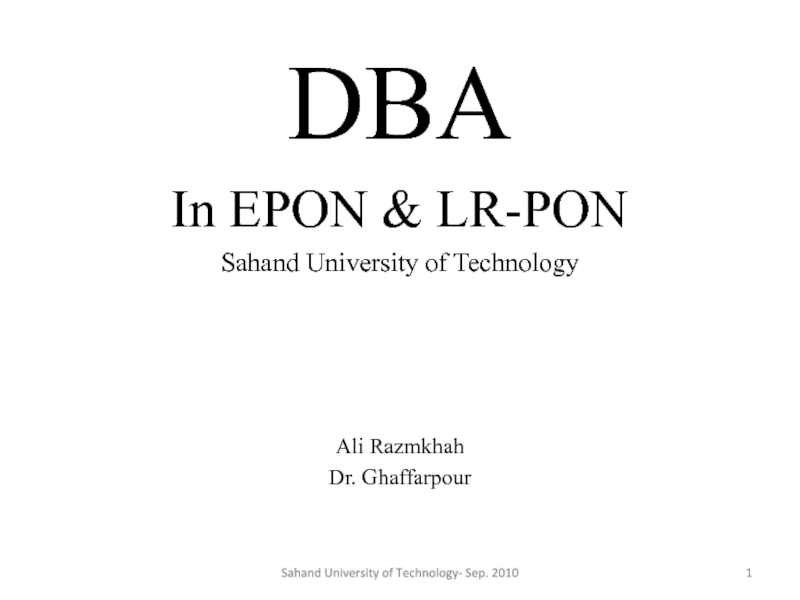
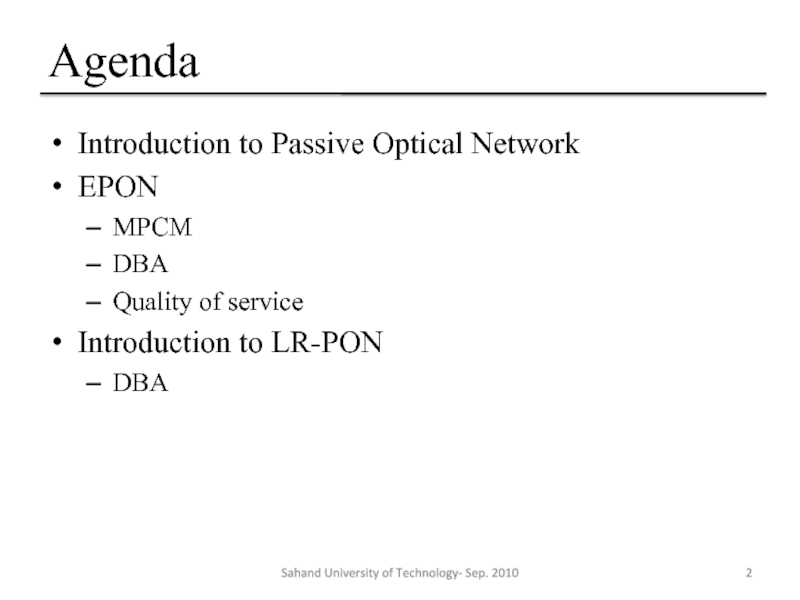

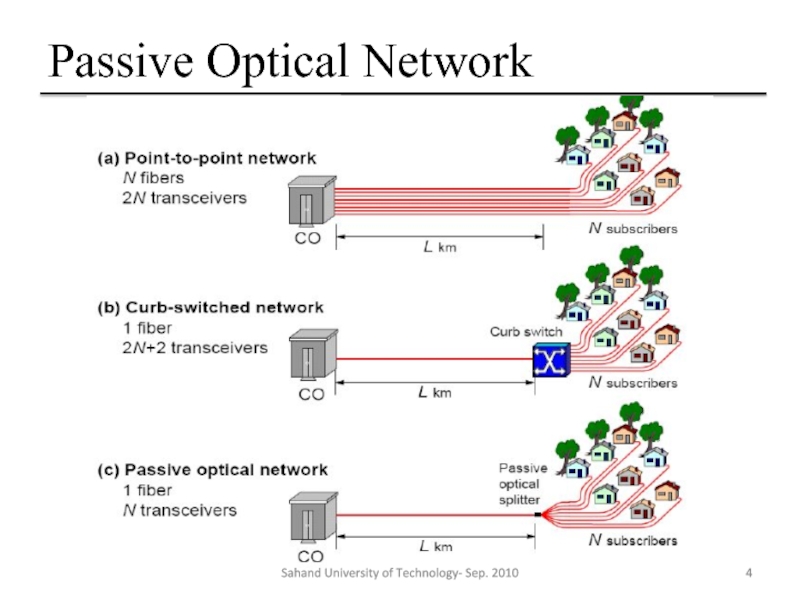
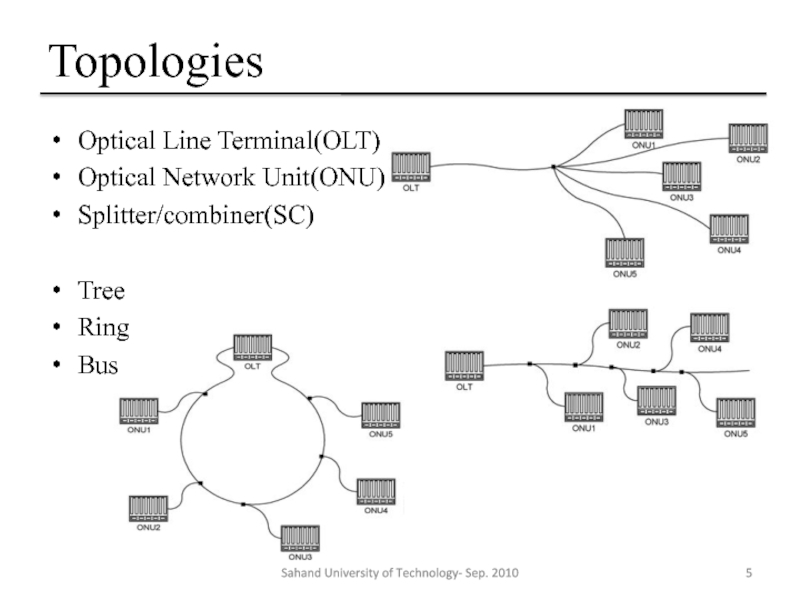
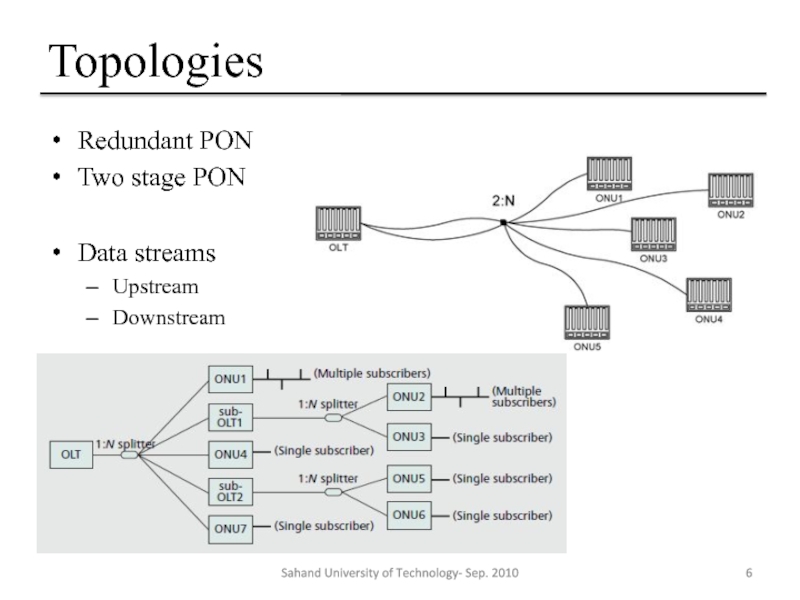
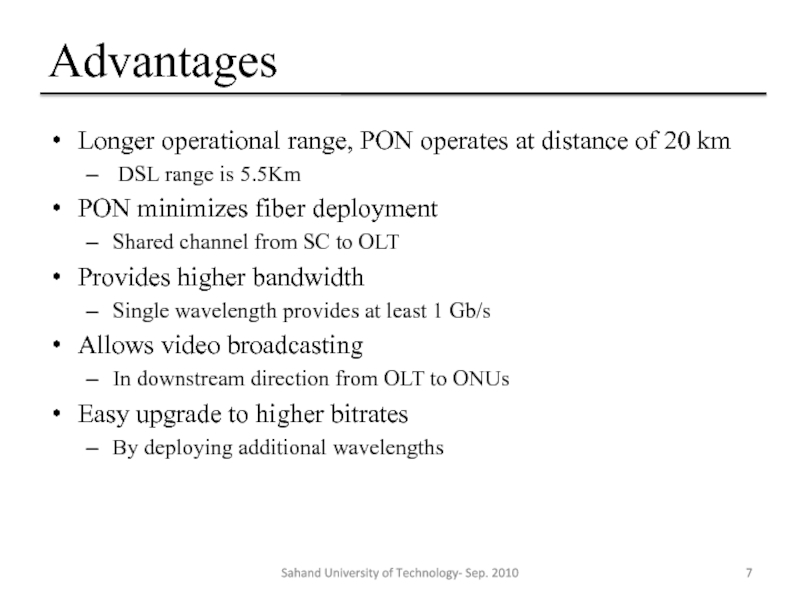
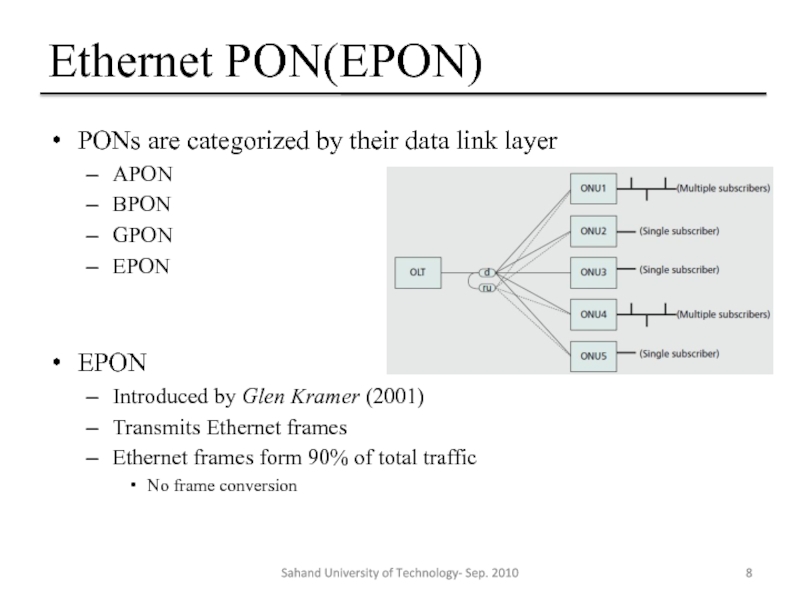


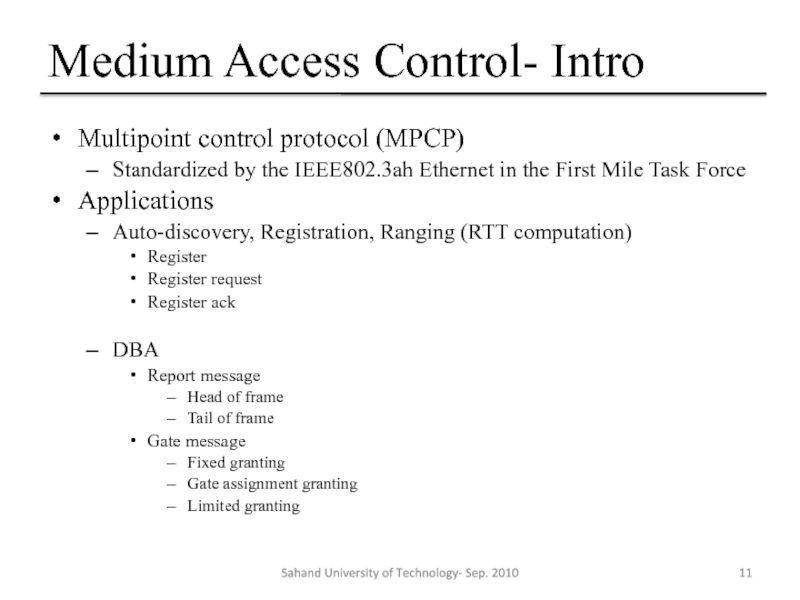
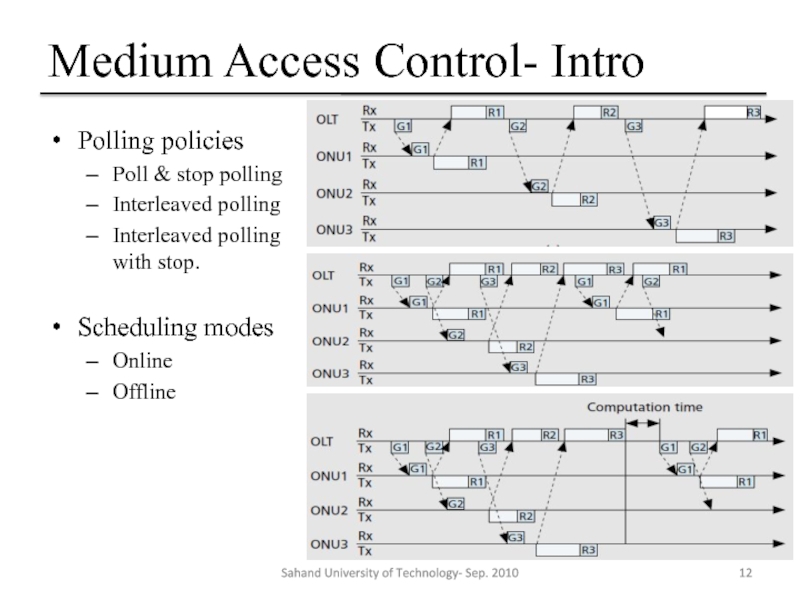
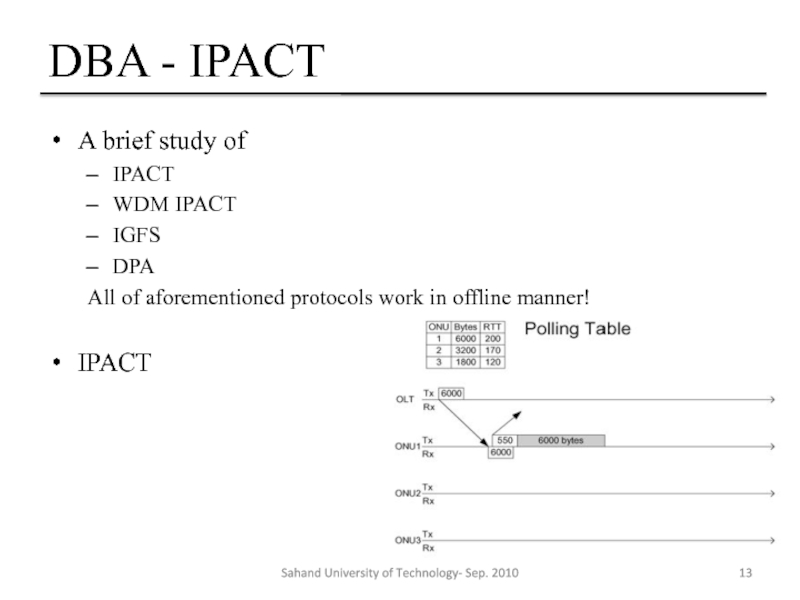
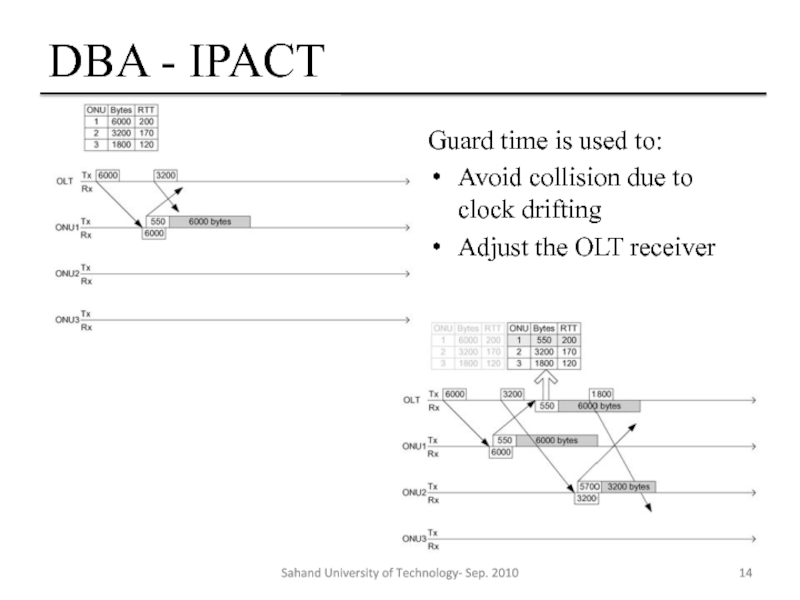
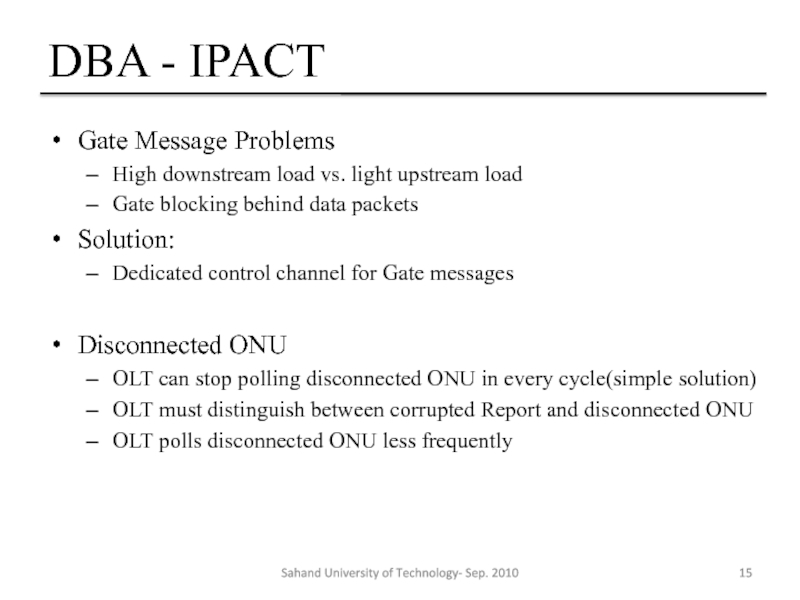
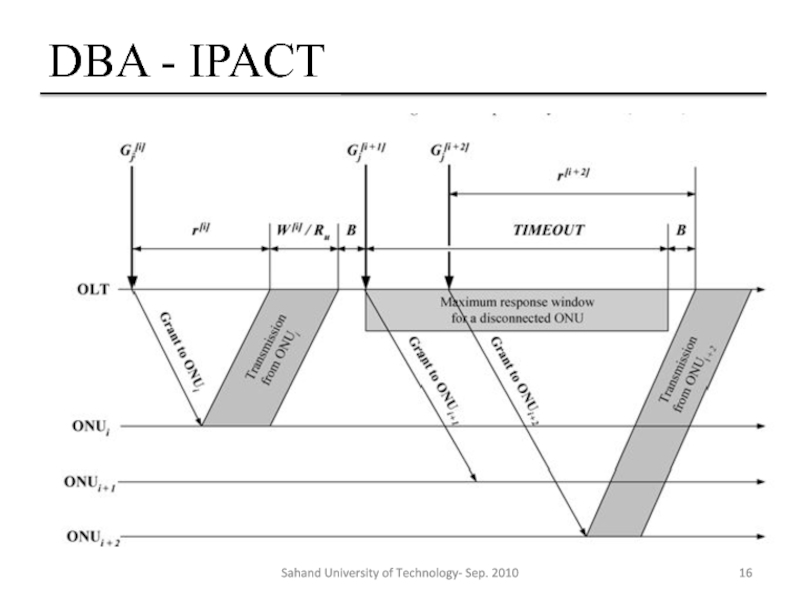

![DBATo more utilization in EPONIn [1] a DBA has been proposed that employs some early](/img/tmb/3/286480/31ee1ae4e1a905e57dda10aa4b3281c7-800x.jpg)
